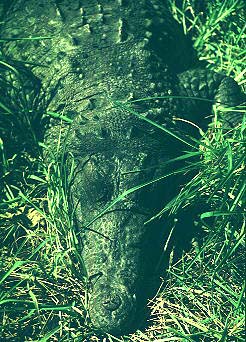
Image (c) Adam Britton, crocodilian.com
Order: Crocodylia
Family: Crocodylidae
Subfamily: Crocodylinae
Genus & Species: Crocodylus acutus
APPEARANCE
The American crocodile is perhaps one of the largest species of crocodiles.
They average at 12 ft (3.5 m) in length, with a maximum length of 23 ft (7
m) — longer than the infamous Nile crocodile. The males are larger than
females, and weigh an average of 500-1000 lbs (220-450 kg). The tail is long
and powerful. They are basically lizard-shape in appearance, with four
squat but powerful legs ending in sharp claws. The snout is long, narrow,
and triangular in shape. The nostrils are located on the end of the snout.
The eyes are on the top of the head and have a nictitating membrane (extra
eyelid) which allow them to see underwater while protecting the eye. The
area around the eyes of mature American crocodiles have a distinct
swelling. The eardrums are located behind the eyes and are covered by a
movable flap of skin. The eyes, ears, and nostrils are all located on the same
plane. The eye's iris is silvery and the pupil is a vertical slit which allows
good vision at night. American crocodiles have a four-chambered heart like
birds.
American crocodiles have conical, pointed teeth on the top jaw which
interlock with those on the bottom jaw. These teeth are used primarily for
grabbing and tearing, not chewing and cutting. The fourth tooth on either
side of the bottom jaw is larger than the other teeth and can be seen while
the jaw is closed.
American crocodiles are not the traditional green in colour. Rather, they
are tan grey or olive grey with darker markings. The belly is white or
yellowish. Juveniles have dark cross-bands on the back and tail which
disappear with age. All ages have backs that are sporadically covered in a
bony armour made up of plates called osteoderms. These plates are more
reduced in the American crocodile than in other species.
HABITAT
American crocodiles are found in the souther tip of Florida, including the
Florida Keys. They are also found in Central and South America and the
West Indies, including Belize, Colombia, Costa Rica, Ecuador, El Salvador,
Venezuela, Peru, Panama, Mexico, Guatemala, Nicaragua, Martinique,
Margarita, Dominican Republic, Haiti, Cuba, Honduras, Hispaniola,
Jamaica, and Trinidad.
American crocodiles prefer saltwater, and are found primarily in saltwater
swamps and marshes, sometimes swimming into the ocean. They can also be
found in freshwater. They dig burrows to escape the heat of the summer,
and will travel long distances on land if their waterhole dries up. They are
active at night, basking near the water during the day.
FOOD
American crocodiles have a slow rate of digestion during the cold weather,
allowing them to go for months without food. The larger crocodiles feed
primarily on small mammals, birds, fish, and crabs. The juveniles feed on
insects, snails, frogs, small fish, and crabs. American crocodiles will also eat
carcasses. They have been known to attack humans and can be
cannibalistic.
American crocodiles hunt by remaining completely motionless in the water.
When prey is close enough, they attack, grabbing the animal and drowning
it. They may also regurgitate bits of food to attract fish.
American crocodiles swallow stones to aide in digestion and to help stabilize
them in the water.
ENEMIES
The American crocodile has few enemies. The smaller ones are sometimes
attacked and killed by the larger ones. Humans are their main threat,
having hunted them from 1930-1960 for their skin. Today, hunting is less of
a problem as they are protected, but habitat loss from dams, fishfarms, and
the evergrowing human population are an imminent threat. They are
considered to be endangered. The largest population is found in the
Dominican Republic, with 200 mature American crocodiles
BREEDING
American crocodiles reach sexual maturity at 8-10 years of age or 6-8 ft
(1.8-2.4 m) in length. The breeding season is between January and May.
Courtship can last for two months, after which the 20-60 eggs are laid in a
hole or mounded nest. The eggs are 24-31 in (60-77 cm) in length and are
protected by a tough and leathery shell. They are covered with sand and left
to incubate for 90 days by the heat of the sun. The parents vigorously
defend the nest during this time. When it is time for them to hatch, the
female digs and helps them out of their nest. She then takes them to a
nursery site along the water and then abandons them. The hatchlings can
fend for themselves from birth.
RELATIVES
There are 23 species of crocodilians found worldwide. The American
crocodile shares its habitat with the American alligator and the Cuban
crocodile.
RESOURCES CITED
1. "American Crocodile" Animal Card, Italy, 1977
2. "Crocodile" Funk & Wagnall's Wildlife Encyclopedia, pg 553, vol 5,
1978, BPC Pub Ltd, NY
3. www.phillyzoo.org/pz0176.htm
4. www.shadow.net/~grgreen/glades/croc.html
5. www.co.miami-dade.fl.us/derm/Crocodile.htm
6. www.bio.bris.ac.uk/research/crocs/csp_cacu.htm (cached at
www.google.com)
7. www.nrca.org/biodiversity/Species/crocodile.htm